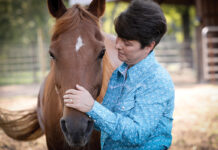
A cooler is a fleece or wool sheet designed to allow a horse to cool and dry without becoming chilled.
Properly cooling out a horse in winter is especially important, when hairy winter coats can trap sweat and moisture. A horse that is either blanketed while still damp or returned to his stall or paddock without being properly dried off has an increased risk of becoming chilled.
There are a few key items you should have handy if you plan on riding your horse through the winter. They include a cooler, baby powder and some towels.
The Cooling Out Process
Once you’re done actively working your horse, take a 10 to 15 minute walk to allow his breathing to slow and to let his temperature return to normal. If you have a quarter sheet or cooler handy, toss it over his hindquarters while you cool out (this is also good for warming up as your horse puts his large muscle groups to work).
If you haven’t covered him with a cooler, loosen you girth when you dismount, but don’t remove your saddle until you’re out of the wind. The cold air on his back could cause his muscles to cramp.
Once your horse is covered in a cooler, you can take him for a long hand walk if he’s still breathing rapidly, or you can allow him to stand in crossties if his breathing is mostly back to normal.
Types of Coolers
A cooler is a wool or fleece covering for your horse that allows heat to dissipate without making your horse cold. Both of these materials have wicking properties that remove the moisture from your horse’s coat, allowing it to dry.
If your horse is very sweaty and you have two coolers available, swap them out when you see moisture bead up on the one covering your horse. Moisture on the outside of the cooler means it is too damp to wick away any more sweat.
 Irish knit sheet
Irish knit sheet
Additionally, if you have an Irish knit sheet, it can be helpful to place this on the horse first, under the cooler. The holes in the knit will create a layer of warm air to help dry his coat, while the cooler will wick away and absorb the moisture.
Other Alternatives
There are a few additional ways you can dry your horse as rapidly as possible. One method is called “thatching,” where you place fluffed up hay or straw under the cooler and directly against his skin. The hay or straw will capture the horse’s naturally dissipating heat and create warmth to dry the damp hair more quickly.
Toweling off the sweaty areas in vigorous circles will also help, as will using a cloth dampened with rubbing alcohol. Baby powder or corn starch will also absorb sweat without the drying effect that rubbing alcohol can sometimes have.
Once your horse’s coat is dry, you can safely turn him out or put him back in his stall. It’s especially important that he be dry if you’ll be putting on a turnout blanket, as these will trap moisture, keeping his coat wet and potentially causing discomfort.
Liked this article? Here’s more on winter riding and horse care:
Horse Health in Winter: Winter Riding
The Big Chill
Ask the Vet: Exercising Horses in Cold Weather
Sarah Coleman has a soft spot for chestnuts with chrome, including her two off-the-track Thoroughbreds that she competes in the hunters. Based in Lexington, Ky., she is the Director of Education and Development for New Vocations Racehorse Adoption Program.






cool
Great advice.